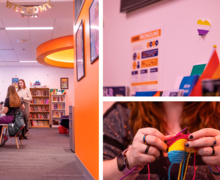First Green Innovation Competition awards $15,000 toward student sustainability proposal
Joe Zhao | Assistant Photo Editor
Josephine Crow and Lilyan Minicozzi won first place at Syracuse University’s Green Innovation Competition. Their project proposes a waste-reduction system for dormitory move-in and move-out.
Get the latest Syracuse news delivered right to your inbox.
Subscribe to our newsletter here.
Sophomores Josephine Crow and Lilyan Minicozzi received the first-place title and a $15,000 grant for their sustainable research proposal at Syracuse University’s inaugural Green Innovation Competition Monday evening.
Their project — “Marmalade: turning university waste into something sweet!” — suggests a waste-reduction and recycling system for move-in and move-out in SU’s dormitories. Crow and Minicozzi directed their proposal toward SU’s Residence Hall Association and Sustainability Management, who will now use the grant money to implement the group’s ideas.
The competition, hosted by the SU Student Association’s Sustainability Forum, featured eight student research proposals finding solutions to sustainability concerns on campus. Olivia Curreri, SA’s vice president of university affairs, said the forum plans to host the contest annually to adhere to the university’s ongoing sustainability goals, which mention similar events.
Curreri said she worked alongside SA’s co-directors of sustainability, Izzy Kaufman and Eniola Festus, to facilitate and plan the competition. The forum has also been working closely with senior administrators — such as Chancellor Kent Syverud and SU’s Board of Trustees — to create and encourage new sustainability goals, she said.
“It’s important that we acknowledge the impacts that SU has on the city of Syracuse itself, so I think by us making this campus more sustainable, the community itself will have to follow suit,” Festus said. “We have a lot of creative minds and young leaders here, and eventually they could possibly work for the city of Syracuse and … bring those great ideas into that community.”
The competition featured a panel of SU faculty judges — Kate Hanson, the director of the Office of Undergraduate Research and Creative Engagement, Kelly Montague, program coordinator of the environment, sustainability and policy major, and Greg Hoke, department chair of earth surface and tectonics.
The competition’s participants came from different majors, backgrounds and departments at SU. Each participant was dedicated to the university’s sustainability goals — updated last year by SA. The new goals include accelerating the net-zero emissions goal by eight years from 2040 to 2032, and a “drastic” phase-out of single-use plastics in the next four years, Curreri said.
Through their research, Crow and Minicozzi discovered that waste accumulation at SU peaks during the beginning and end of the school year, as students often discard unneeded items when moving in and out of campus housing. Their project found the university could prevent waste through an on-campus redistribution system for discarded dorm items, according to their proposal.
“Reusing things and not contributing to the massive waste problem we have in the U.S. is a big part of our lives, so having this implemented on campus is really important,” Minicozzi said.
Crow and Minicozzi, both industrial and interaction design majors at SU, said they have been dedicated to solving sustainability concerns for a while.
Part of their proposal also encourages general awareness of waste issues at the university. With their proposal, students can volunteer to sort their discarded dorm items into categories, such as clothing, kitchenware, bathroom supplies and electronics.
“Students will then maybe think twice before throwing away an item that is still usable… they’ll think about donating it instead of throwing it in the trash,” Minicozzi said.
Other proposals ranged from robot designs to solar and wind power initiatives. All participants pitched their ideas to the judges, identifying a sustainability concern on campus and a potential solution.
One project, designed by Marco Svolinsky and Dominic Clinch — both seniors in the School of Engineering and Computer Science — proposed to replace Link Hall’s lighting infrastructure with new energy-saving LED light bulbs and occupancy sensors.
Svolinsky and Clinch individually counted all of the lightbulbs in Link Hall and made a cumulative chart of the potential electricity and money saved.
“There are plenty of other universities that are just as old as ours,” Svolinsky said. “If they can see our university taking the initiative to do the upfront cost, and then posting their sustainability and savings year over year, other universities and institutions are going to be more inclined to take that initiative and jump that hurdle as well.”
SA plans to host this event again next year with hopes for an even larger turnout, Kaufman said.
“There is a ranking system that ranks how sustainable your campus is. We’re silver now. We have potential to move up,” Kaufman said.”Seeing that happen as a result of this competition and this competition happening for a few years would be super.”
Published on April 9, 2024 at 12:32 am
Contact Kate: kjacks19@syr.edu






